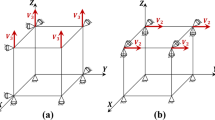Abstract
The identification of material parameters of a brass alloy using single point incremental forming (SPIF) is presented. The determination of accurate law parameters for metal sheets in the whole range of their plastic deformation field is a challenge in order to reach efficient forming simulations of manufacturing processes. The identification is performed using a homemade optimization code based on Levenberg–Marquardt algorithm. To validate the previously identified material data, an identifiability method is developed. This method consists in measuring the influence of a material parameter on the SPIF test by analyzing the sensitivity matrix. Such information permits to assess the capacity of a SPIF test to be used to identify the material parameters. A consisting scalar (the identifiability index), concluded from the highest and the lowest eigenvalues of the Fisher’s matrix, gives an indication about the most appropriate SPIF tests to identify the material data.
Access this chapter
Tax calculation will be finalised at checkout
Purchases are for personal use only
Similar content being viewed by others
References
La Fontaine A, Keast VJ (2006) Compositional distributions in classical and lead-free brasses. Mater Charact 57:424–429
Alaboodi AS, Al-Mufadi F, Modeling BP (2018) Cold deformation of dezincification resistant yellow brass for plumbing Cold deformation of dezincification resistant yellow brass for plumbing applications. Mater Manuf Process 33(15):1693–1700
Skibicki D, Pejkowski Ł (2017) Low-cycle multiaxial fatigue behaviour and fatigue life prediction for CuZn37 brass using the stress-strain models. Int J Fatigue 102:18–36
Echrif SBM, Hrairi M (2011) Research and progress in incremental sheet forming processes. Mater Manuf Process 26(11):1404–1414
Brun R, Reichert P, Künsch HR (2001) Practical identifiability analysis of large environmental simulation models. Water Resour Res 37(4):1015–1030
Richard F, Villars M, Thibaud S (2013) Viscoelastic modeling and quantitative experimental characterization of normal and osteoarthritic human articular cartilage using indentation. J Mech Behav Biomed Mater 24:41–52
Henrard C, Bouffioux C, Eyckens P, Sol H, Duflou JR, Van Houtte P, Van Bael A, Duchêne L, Habraken AM (2011) Forming forces in single point incremental forming: prediction by finite element simulations, validation and sensitivity. Comput Mech 47:573–590
Reichert P, Vanrolleghem P (2001) Identifiability and uncertainty analysis of the river water quality model no. 1 (RWQM1). Water Sci Technol 43(7):329–338
Ben Hmida R (2014) Identification de lois de comportement de tôles en faibles épaisseurs par développement et utilisation du procédé de microformage incremental. PhD Thesis, Supervisor: S.Thibaud, University of Franche-Comté
Gujarati D (2004) Basic econometrics
Guzmán CF, Yuan S, Duchêne L, Saavedra Flores EI, Habraken AM (2018) Damage prediction in single point incremental forming using an extended Gurson model. Int J Solids Struct 151:45–56
Bouffioux C, Henrard C, Eyckens P, Aerens R, Van Bael A, Sol H, Duflou JR, Habraken AM (2008) Comparison of the tests chosen for material parameter identification to predict single point incremental forming forces. In: Proceedings IDDRG 2008 International conference, Olofström, Sweden, pp 133–144
Ben Bettaieb A, Velosa de Sena JI, Alves de Sousa R, Valente R, Habraken AM, Duchêne L (2015) On the comparison of two solid-shell formulations based on in-plane reduced and full integration schemes in linear and non-linear applications. Finite Elem Anal Des 107:44–59
Habraken AM, Cescotto S, Banning Q (1998) Contact between deformable solids: the fully coupled approach. Math Comput Model 28(4):153–169
Acknowledgements
FNRS Research Director A.M. Habraken acknowledges the support from Belgian Fund for Scientific Research (FRS-FNRS). This SPIF research is funded by the PDR MatSPIF-ID FRS-FNRS.
Author information
Authors and Affiliations
Corresponding author
Editor information
Editors and Affiliations
Rights and permissions
Copyright information
© 2022 The Minerals, Metals & Materials Society
About this paper
Cite this paper
Betaieb, E., Duchêne, L., Marie Habraken, A. (2022). Identification and Validation of Brass Material Parameters Using Single Point Incremental Forming. In: Inal, K., Levesque, J., Worswick, M., Butcher, C. (eds) NUMISHEET 2022. The Minerals, Metals & Materials Series. Springer, Cham. https://doi.org/10.1007/978-3-031-06212-4_79
Download citation
DOI: https://doi.org/10.1007/978-3-031-06212-4_79
Published:
Publisher Name: Springer, Cham
Print ISBN: 978-3-031-06211-7
Online ISBN: 978-3-031-06212-4
eBook Packages: Chemistry and Materials ScienceChemistry and Material Science (R0)




